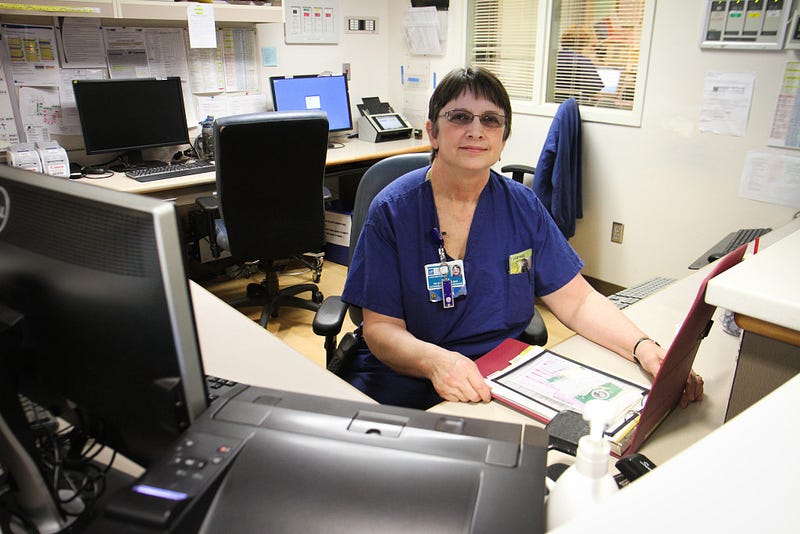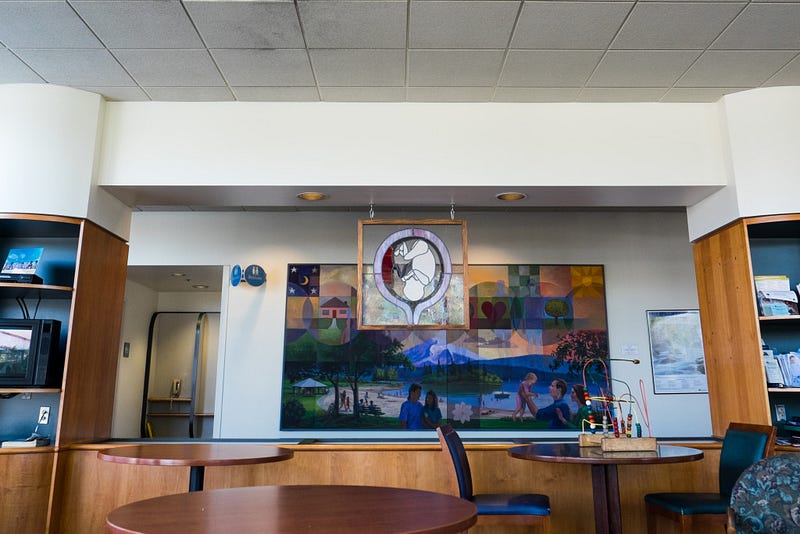Sacred Door
Nurses and mothers build relationships to foster new life
STORY BY JOYCE HEBERDEN | PHOTOS BY JAKE TULL
(Above) A locked door separates the waiting room from the birthing rooms in the St. Joseph Hospital Childbirth Center. Only nurses and visitors over the age of 12 may go past the door.
It’s 8 a.m. The Childbirth Center at St. Joseph’s Hospital is still warming up for the day. The only person to be seen in the waiting room is a man who sits in the corner reading a magazine, throwing out his wrist and looking at his watch every minute or so. One might expect this place to be busy at all hours, but it seems this is a slow time as nurses chat with each other while taking a break.
The receptionist’s phone rings every 10 minutes or so. The man sitting in the corner lifts his eyes from the magazine every so often. He’s waiting for someone. Nurses pop out of the door, which leads to the delivery rooms and expecting mothers. This realm is forbidden for the public to enter. Birth is private, and in many ways, it is sacred.
There seems to be a certain energy coming from the other side of the sacred door, it’s exciting, like pressing an ear against a beehive. Invisible commotion, atoms flying in every direction, setting the universe straight once again.
Birth is a work of art, as it takes patience, experience and more importantly, courage
A nurse finally emerges from the sacred door, and, asked if she’d be willing to talk about her work, if some of her other colleagues could find time to talk about their work, she says she’ll try to help. She smiles, explains she’ll be back, and then returns behind the door.
It’s 9 a.m. and Catherine Goff looks out the window to clear her mind.
“You get to regain a certain respect for Mother Nature,” Goff says. “It kind of scares me to see a baby be born, it’s amazing what you can do to a human body.”
At the same time, next to the miracle of life and its beauty, there are some aspects of motherhood that are often unheard of and muffled behind the sacred door. There comes exhaustion from motherhood, sometimes due to postpartum depression. Goff mentions that more often than not, mothers suffering from drug addictions experience this negative side of motherhood.

The buzzing nervousness in the center brings deep concerns about the child’s future. Babies being addicted to heroin from birth, teenagers giving up their babies to foster homes. Goff mentions mothers with medical conditions who have babies regardless of their illness.
“They’re not bad people, just because they have children under those circumstances,” Goff says. “As long as they know what it entails.”
The nurse’s perspective on the miracle of life and the beauty of birth can sometimes be tainted by these harmful conditions. They can be tricky, but Goff has found that confronting these problems in her professional life gives her the drive to help new mothers.
“It’s a huge privilege to be at a person’s delivery,” Goff says. “All deliveries are different, first-time mothers usually takes 12 to 14 hours to deliver,” she says.
When Goff had her own children, she had confidence that she could go through the birthing process, based on her experience. And while she’s been working in obstetrics, the science of pregnancy, for years, she still finds surprises in every birth, good and bad.
After a small lull in the conversation she suddenly wants to be reassuring. The good things make the bad things seem smaller, she says.
It’s 10 a.m. and Sarah Nowell takes off her glasses to rub the bridge of her nose and the creases created by them. She enjoys working with first-time mothers to help them understand the process of breastfeeding.
“It was my dream job… Every day I pinch myself because I can’t believe I’m working the day shift in obstetrics,” Nowell says. “It never gets old.”

Helping new mothers is something she always wanted to do. Contrary to popular belief, motherhood is not a natural talent that all women are born with. Because of this, people like Nowell are there to help women acquire the skills, physically and emotionally.
Some mothers embrace their new status fully as a new way to self-identify themselves while others see it either as a burden or job, preferring to distance themselves from the label of mother. Postpartum depression affects about 14 percent of women after giving birth, according to the American Psychological Association. It can be dangerous for the mother as well as the baby. This prolonged malaise from motherhood can be prevented or treated through check-ups and Nowell is the nurse to do it.
Postpartum depression screenings for mothers during and after birth have increased in recent years. This is especially important for first-time mothers, as they may be experiencing symptoms such as depression, anxiety and obsessive compulsive disorder without knowing how to cope.
Nowell returns behind the door and a few minutes later, Kari Eastman comes out for a glass of water and a small chat with the receptionist. She leans against a wall, taking the weight off her feet.
“They’re excited, nervous, fearful of the unknown,” Eastman says. “First time mothers come into the center with big bags full of every bottle, device or blanket they had in their possession at home they thought could be used after the delivery. They are ready for it, they’ve read all the books.”
Eastman says the real anxiety comes from third-time moms, because they know what they’re getting into. The first-timers are excited they’re in labor, the second-time mothers deliver much faster and the third-time mothers usually have more anxiety.
“They’re like ‘Oh my god, I’m doing this again, I don’t know if I can do this,’” Eastman says.
But the rush of adrenaline felt by the new mother can be easily subsided by the kind words of the nurse. She knows what they’re going through. She sees it every day. She tells them they’re going to be a good mother.
The fear of labor and delivery are only a fraction of what mothers and nurses worry about. They support each other’s anxieties and the nurses in particular feel a very special attachment to the baby, almost the way a mother would.
This symbiotic relationship between the nurse and the mother is a large component of the delivery process. The nurses are there not just for the delivery, they are there to ease the birthing process as a whole.
It’s obvious that while they are happy to answer questions, the nurses can’t wait to get back behind the door into the sacred realm. The beauty and hope that birth gives is enough to make a pessimistic man smile.

Two women holding a baby come out from the sacred door. The man sitting in the corner looks up, grins, and puts down the magazine. He walks up to them and wiggles his fingers in front of the cooing baby.
The person he was waiting for has been delivered and the quiet waiting room suddenly feels full of the electricity that could be felt behind the door. The new little family hustles out the door to a misty January morning.
It’s almost 11 a.m. and a visitor can’t help but feel a little different about birth walking back out into the world.